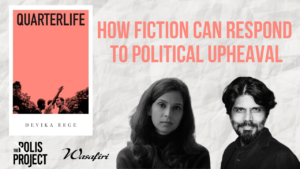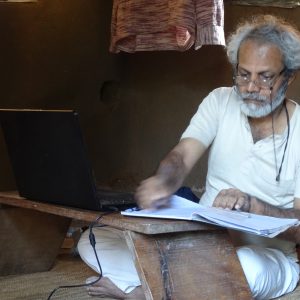
India’s is an agrarian economy, yet a farmer would rather be a doorkeeper with a monthly salary: Why? An interview with Prof Debal Deb

What are the greatest challenges facing Indian agriculture? It is not the burning question of the day—successive governments have systematically abandoned sustainable, traditional practices. The entry of corporate firms in agriculture (and banks, subsequently) not only affected long-term sustainability, the new farm bills passed by the government threaten to take over whatever little autonomy farmers had on the crops by opening up the markets to private players who would control the prices, taking away any government responsibility. Parul Abrol explores these issues in this conversation with Debal Deb. Well known for saving traditional varieties of rice, Deb is an ecologist by training. He is also a teacher, a conservator of endangered biota, and a fierce critic of corporate interests in agriculture.

Parul Abrol: What’s the biggest challenge facing Indian agriculture?
Debal Deb: The biggest challenge is to retain and restore the knowledge of sustainability. About 90 percent of mainstream farmers have lost their entire traditional knowledge of agro-ecological sustainability. The remaining are farmers on marginal lands. These include tribal areas, untouched by modern agricultural technology and techniques; drought-prone areas, where there’s frequent drought or no irrigation facility; wet lands or deep-water lands periodically or seasonally flooded. These are areas where Green Revolution seeds cannot perform at all. Farmers have to depend on their own heirloom seeds that are perfectly adapted to the drought conditions. None of the modern varieties will survive there, let alone yield any grain. Same goes for the coastal areas.
These marginal lands are the last havens of traditional heirloom varieties of rice and other crops that are adapted to local environmental conditions. But even here, people are abandoning these seeds and traditional cultivation techniques and adopting “modern” seeds and technology. For the greed of higher yields, they abandon their own seeds and cultivate new varieties which, predictably, fail. And when they want their seeds back, it’s all lost because rice seeds cannot remain viable beyond two years. That’s how thousands and thousands of varieties have been, and continue to be, lost.
Farmers are also abandoning farming as an occupation. No farmer today wants their children to farm. It’s been turned into a derogatory, demeaning occupation. It’s such a sharp contrast to Russia and Europe. In the US, I’ve seen many university professors who are also amateur farmers. Outside the academia, they proudly introduce themselves as farmers. India is agrarian by economy, yet a farmer would rather be a doorkeeper with a monthly salary. That’s the challenge.
Many people argue if you leave modern technology and shift to traditional farming, the country will fall back on food security and go back to the days of importing food grains. What do you say?
It’s a ridiculous argument; I partly answered it already. Show me a single modern variety seed from the Green Revolution which can grow on zero-irrigation land. Show me a single modern variety seed which can grow in five-foot- or ten-foot-deep water, or a seed that can grow in sea water. What about food security on such marginal farmlands? According to government figures, about 40 percent of India’s agrarian land is now marginal land. Forty percent! If there is no irrigation facility in drought-prone areas, for example, where’s food security there? People there survive only because food comes from traditional agriculture, traditional seeds.
To say that our production was stagnated, and therefore we had to import, is a complete lie recent studies have now exposed.It is a Goebbelsian truth that if we didn’t have the Green Revolution, we would have been importing seeds, that we didn’t have food security before. To say that our production was stagnated, and therefore we had to import, is a complete lie recent studies have now exposed. Another part of this lie consists in what we call production. I’m not saying “yield,” I’m saying productivity of rice or wheat per unit area. Say, the average productivity of those rice varieties was X units in 1965 at the onset of the Green Revolution. Decades later, the average productivity of the modern varieties is less than X. You will find this if you encounter a farmer who can recall past records of productivity—someone about 80 years old today.
When I started my research, 50-year-old people could remember it clearly. For example, a rice variety was giving about 5.5 quintals per beegha, that’s about 17 quintals per acre. In some cases, it was 24 quintals per acre on zero input. Today, with second- or third-generation high-yielding varieties, it’s less than 14 quintals. If the Green Revolution seed is giving 14 quintals, and pre-Revolution seed was giving, say, at least 15 quintals, why should we opt for the Green Revolution variety? We now consider 14 quintals as the highest possible because we have no other option or evidence. Farmers now cannot give a reference that we had a variety that gave 16 or 17 quintals per acre. Now the best possible variety at hand is Lalat or IR-36 or Swarna, yielding not more than 15 quintals per acre, that’s the benchmark. In our Basudha farm, we are demonstrating varieties which give 20 quintals per acre.
So even going by the absolute quantitative production, many folk varieties outperform modern varieties. That’s why it’s now called the Actual Yield. The scientific definition of yield is output per unit of input. By that definition, that is, if you consider inputs such as nitrogen or water or energy, every single heirloom variety is higher yielding than any of these modern varieties.
Again, there’s what I call semantic imperialism. When you call IR-36 “high-yielding” variety, it implies other varieties by definition are “low-yielding.” A farmer who is already cultivating a variety that is higher-yielding is made to think that his variety is lower-yielding so he must grow the “high-yielding” IR-36. Thus, genuinely high-yielding folk varieties are abandoned.
Then there are other factors. The increase in cereal production over the decades, for example, is not because of better seeds but other factors. In Evanson study published in Science in 2003 and also in my analysis published in 2004, the contribution of the seed quality to the growth in cereal production was less than 14 percent. The primary cause of growth in cereal production was that more land was brought under the plough. If you had one acre of land and now you have three, obviously your output will increase.
This involves land-area estimation involving gross area and net area of gross production. For example, you were growing one acre of land and one crop a year. Now because of new irrigation facilities you are capable of growing two or three crops a year. So in the same geographical area, your output is doubled. Not because of the seed quality but how frequently you are using the land.
Another factor is irrigation facility. Irrigation canals apart, more than 27 million tube-wells were sunk throughout India during the last 50 years for irrigation purpose alone. And the number is increasing because in most cases they become dysfunctional in a few months. So you sink another one. Forget about the cost of the groundwater depletion and other environmental damages, accessing more and more water in otherwise unproductive land is enhancing production.
So the increase in cereal grain production is not a factor of seed quality of the Green Revolution, it’s because of these other non-biological factors. Also, more irrigation leads to more productivity. This is my own analysis, using government data. So that’s the Green revolution story of cereal output growth. Then there is decline in soil fertility because of the overuse of chemicals. There’s groundwater depletion and contamination, soil erosion and salinization, and crop contamination with insecticides and herbicides…
Would you elaborate on this in case of hybrid seeds…
Well, if you consider the environmental impact and health cost, soil erosion and sterility cost, biodiversity cost, cost of seeds—for hybrid crops you have to buy them every year—it will always be higher…
And diseases?
Yes, there are nerve diseases and kidney diseases, there’s contamination by pesticides, build-up of pesticide-resistant pests and herbicide-resistant super-weeds. There’s erosion of bio-diversity, species extinction, loss of genetic diversity of crops, and ecosystem extinction. Then you have social costs. Yield gap leads to income gap, dispossession, and migration of small farmers.
Many in the academia and bureaucracy are simply ignorant, they believe there are no alternatives.Unfortunately, even if institutional agricultural scientists know this is happening, they avoid talking about it since they have their careers at stake. Many in the academia and bureaucracy are simply ignorant, they believe there are no alternatives. Then there are the farmers who simply believe that because the majority or the wealthy farmer is doing it, I should also do it, a notion many agricultural officers push; they tell them if you don’t apply herbicides or pesticides or use these seeds, you are backward and unscientific.
Finally, there are people who know what they need but they just don’t have access to those seeds anymore. These are the people for whom Vrihi and Basudha seed banks were set up, and we’ve been supplying them these seeds for over 20 years now. We do it for free while many others, including those who originally took the conserved seeds from us, charge huge fees. To my knowledge none of the NGOs, for example, are working to save the genetic purity of seeds.
I read there have been attempts by multinational companies to steal your seeds…
Yes. They sent scouts, several times. They also used other ploys. Some three years back, a company in Hyderabad called me up. They said they were so impressed about this work of conservation that they wanted to help me and offered me the company’s gene bank facility: seed storage facility for hundreds of thousands of seed packets, very protected, minus 20 degree Celsius, you can keep the seeds viable for three decades, free of cost, and you can use it for as long as you want. I thanked them and asked who are the other people using this facility. They said Monsanto and Syngenta. Now that’s excellent. Monsanto is using their facility and they are offering it to me as well. I asked them about the access. They said if you are concerned, we can give you the key to the vault, it will be yours, nobody else can access it. I said it’s your vault, you can have three or four copies of the same key, one to Monsanto, one to yourself, one to me, how do I trust? I said, all my work, all my life, has been against Monsanto, Syngenta, and such kind of seed companies, and you are asking me to share space with them and give them access to all my life’s collection for free?
Why is genetic purity so important?
Without genetic purity you cannot say it’s the same variety you’ve been growing for years. Take basmati rice. It has baas, which means aroma, fragrance. Now there’s no fragrance yet you call it basmati just because it is a long grain. This decay of genetic character can be a result of random natural mutations or genetic intermixing by cross-pollination, but it can also be due to physical mixing of different seeds. You begin with variety X and in a few years you end up with variety Y yet you continue to call it X.
Not just aroma, the genetic character lost could be drought tolerance. You know variety X was drought-tolerant yet in three years it dies in drought because that character is lost. Now you cannot prevent mutation but the task of the farmer, the conservator, is to weed out the “off types.” You have to eliminate them and maintain pure-line seeds from the core samples to maintain purity of traits. It’s a very meticulous thing to do and all traditional farmers used to do it. Now we [at Basudha] have scientific equipment and scientific knowledge to not only do it ourselves but also train others.
What did you learn from working with the Adivasi communities?
I have worked with 15 Adivasi communities in India, three in the US, and two in Thailand and there are amazing scientific techniques we are rediscovering. Techniques of rouging, for example, to identify the off types and remove them in order to maintain genetic purity. There are ways of increasing the complexity of agro-ecosystems by integrating trees and shrubs and herbs, maintaining non-food plants along with food plants and animals, and all these kinds of things. There are soil treatments such as application of bio-char, a very ancient technique which the world is learning all over again. I see this as ecological integration and there’s value in it, which most agriculturists fail to appreciate because in the modernisation agenda—not just in agriculture but forestry too—the motto is simplification, homogenisation.
Be it northern or southern India, you find hectares and hectares of farm without a single tree. That’s truncation of diversity—architectural diversity, species diversity, genetic diversity.So, in the forests you see rows and rows of pines, rows and rows of eucalyptus, or thousands of hectares of teak—it’s a monoculture of teak, of eucalyptus, it’s simplification, homogenisation. Similarly, thousands of hectares of rice fields with IR-36 alone is homogenisation. Be it northern or southern India, you find hectares and hectares of farm without a single tree. That’s truncation of diversity—architectural diversity, species diversity, genetic diversity. This is completely against the traditional knowledge system of building and fostering complexity. But our agriculturists, following the modernisation curriculum manufactured in the US or Europe, have forgotten that our soil is so productive with thousands of biota in it. First they destroy the soil biota, then they pump in nutrients that were originally available for free in nature.
So, we are creating problems for agriculture on our own?
Not just agriculture, it’s a general challenge to the entire education system in India. In our village for example, in the primary schools, they teach the English alphabet, so the kids are taught A for apple, P for peach, G for giraffe, Z for zebra in a remote tribal area where there’s hardly any peach, but they are mugging this up. They are not taught any of the kendu and chakoli and kantakoli and all these dozens of different kinds of wild fruit which they consume round the year. They won’t remember any of these things for long but they know what is peach, orange, giraffe, zebra. And then you go to the market and buy apple, grape, peach.
This is what Marxists would call “comprador capitalism”—you don’t create anything, you don’t innovate anything, you just assemble things created by others.Urban people, say in Kolkata, would prefer apples imported from Australia and pasted with barcodes than apples from Shimla. Similarly, the Darjeeling mandarin or orange is of low value than the orange imported from Europe. Now they don’t know the same orange they are buying was perhaps exported originally from Darjeeling and came back here. The entire development paradigm in India is… there’s no innovation. This is what Marxists would call “comprador capitalism”—you don’t create anything, you don’t innovate anything, you just assemble things created by others. You’re just a middle man out to make money.
People know you as the rice conservator, but would you share the fascinating story of the last tree of its kind that you rescued… it’s the story of the decay all around us.
How should I explain this, saving sacred groves, saving a plant from extinction… nobody knows I’ve planted it here. It is perhaps the last specimen in the whole region. There are other examples too, but people only know about my rice collection because it involves big numbers. So this one is a big tree which I discovered at Chhandar village in Bankuda district in West Bengal during my work on sacred groves (revered or worshipped by the indigenous people). I was standing at a bus stop, and it’s my incorrigible habit of keeping my eyes and ears open, so I was looking around. I was standing at a destroyed sacred grove, which was turned into a roadway. The grove was left in three fragments as the roads perforated it. They chose the junction, I later gathered, because they wanted to cut about 80 big old trees there. The contractors earned big. In the fragments, I later identified all the trees and counted all the species. But I got stuck at one tree which I couldn’t identify. I am not a botanist but I know most of the forest trees in Bengal and Orissa, yet I couldn’t name this one. I asked the villagers, they couldn’t tell the name, it was so unfamiliar. Then I collected specimens of leaves and flowers and sent them to the Botanical Survey of India. They took eight years to identify the family and finally the genus, but not the species.
I enlisted the service of one of my botanist students, now in Calcutta University. And he named one probable species. In 2014, I was invited to a conference at the world’s largest botanical garden, Royal Botanic Garden, in Kew. I sought a permission to study in the herbarium for a day. I thought this might be a new species, a new discovery, a new description. It wasn’t. I found it there. It was described some 170 years ago by Hooker and others. I saw the herbarium specimen and confirmed that’s the species.
In the preceding ten years I had surveyed the entire West Bengal, part of Orissa, Bangladesh and the districts of what is now Jharkhand—a total of 10,000 sq km—yet I found no other specimen. This happens to be the last. And meanwhile, there were at least two attempts by the local committee to fell it…
Why?
Well, when I opposed, they said cutting the tree would fetch some 500 rupees to the poor.
But why were they after that tree?
Not just that tree. And for money. I forgot all my work, stayed put there and convinced the villagers about its value. It was so difficult… this tree gives no food, no valued timber, it’s not known as a medicinal plant. But I was able to convince them that it’s such a unique species found nowhere else in the country, you should be proud because yours is the only village that has it. Finally, the felling spree stopped.
All this time I tried to germinate the seeds but they didn’t. There are many trees which cannot germinate from seeds unless it is eaten by animals. Like Banyan tree. Unless it passes through the gut of a bird, it cannot germinate. Since this tree was by a busy roadside, no animal was approaching it. All attempts failed and the only option left was tissue culture. I approached many tissue culture laboratories. The only question they asked was, “What’s its economic value?” Because I couldn’t give any economic value, they said “get lost.” They would be interested in tissue cultures of banana, papaya, or potato… that will fetch money. Then I approached the National Bureau of Plant Genetic Resource. They have a tissue culture unit meant for endangered species. The person heading it said “yes, definitely, we will do it, just let us know when the season is coming…” and then she retired. I faxed to the office, emailed them… no response. For twelve years, it went on.
We had no guidance, no references, we devised our own method with my research students. We germinated about 150 seedlings and saplings.Back there, every day, I thought they cut it, maybe for road-widening or simply for the wood. Finally, three years ago I got my own lab and it became one of my first tasks. I collected the tissue from Kolkata, it had to be very quickly transported in liquid nitrogen with hormones and other chemicals. In two attempts we made it, collecting two batches of tissues. I spent 36,000 rupees on just that occasion, forget about the tissue culture expenses. Two years later finally, and for the first time in the world, we were doing a tissue culture of this group. We had no guidance, no references, we devised our own method with my research students. We germinated about 150 seedlings and saplings. Mortality was very high. Just two survived. Then in 2016, when we wanted to get another batch of tissues for more saplings, we were told the tree was no more. They had felled it… (dejected silence).
And it’s not that the villagers didn’t know. They knew it for 16 years. I worked with them, talked to them, explained its intrinsic value. Yet the tree was felled. They took advantage of my absence from Bengal, probably they were waiting for me to leave. Anyway, we had these last two specimens in our lab from tissue culture and I promised I won’t plant them in Bengal. We shipped and planted them here, in this village—Karandiguda, Odisha—and I’m happy in this remote place.





